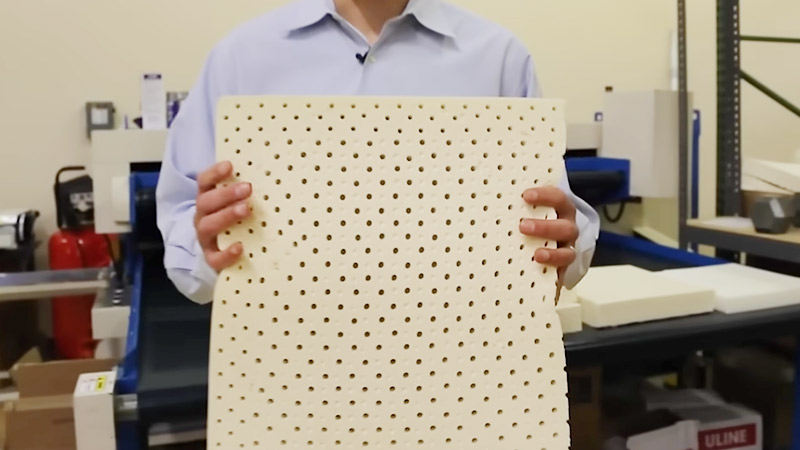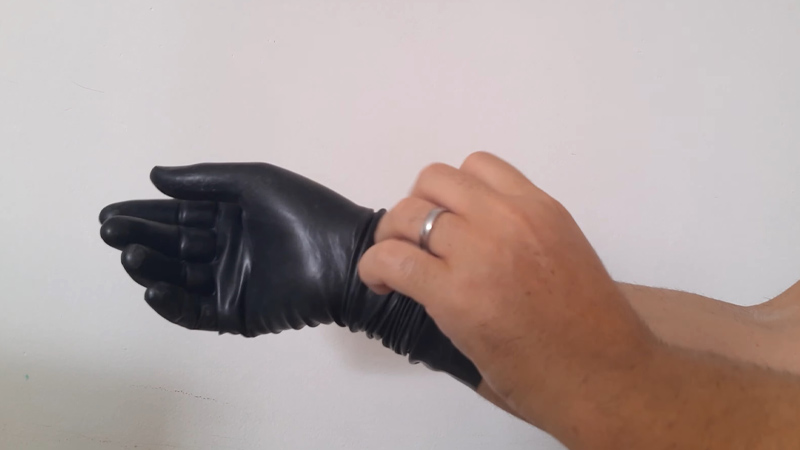Craft foam is a beloved material in the world of crafting, cherished for its versatility and ease of use. Yet, for those with latex allergies or sensitivities, a crucial question lingers: Does craft foam contain latex?
This inquiry is pivotal, as latex can provoke allergic reactions ranging from mild discomfort to severe health concerns.
The answer, however, is not straightforward, as it depends on the specific brand and type of craft foam. Some products openly declare their latex content, while others remain silent on the matter.
This ambiguity underscores the importance of meticulous examination, ingredient scrutiny, and precautionary measures when working with craft foam to ensure a safe creative journey.

What Is Craft Foam?
Craft foam is a versatile and widely used material in the realm of arts, crafts, and DIY projects. It’s a type of foam sheet or board that is specifically designed for crafting purposes.
Craft foam is valued for its flexibility, ease of handling, and the plethora of creative possibilities it offers.
Typically made from expanded polystyrene (EPS) or polyethylene (PE) foam, craft foam comes in various thicknesses, colors, and textures, catering to the diverse needs of crafters. It can be found in sheets, rolls, or pre-cut shapes, making it adaptable for a wide range of applications.
Craft foam can be easily cut, shaped, and manipulated using scissors, craft knives, heat, or even die-cutting machines. It adheres well to various surfaces and can be glued, stapled, sewn, or heat-bonded to other materials.
Crafters use it for an array of projects, from creating decorative items like greeting cards, masks, and party decorations to more intricate applications such as costume design, cosplay props, and model-making.
This lightweight and affordable material has become a staple in the crafting world, enabling artists, hobbyists, and DIY enthusiasts to turn their imaginative ideas into tangible works of art. Its accessibility and adaptability make craft foam a go-to choice for both beginners and seasoned crafters alike.
Does Craft Foam Contain Latex?

Craft foam is a popular and versatile material used by craft enthusiasts for a wide range of projects. It is appreciated for its ease of use, ability to be cut, shaped, glued, painted, and more.
However, one important consideration when working with craft foam is whether it contains latex, a natural rubber compound that can cause allergies in some individuals.
The presence of latex in craft foam products is not uniform and can vary depending on the brand and type of foam.
Some craft foam products are explicitly labeled as containing latex, while others may not mention it on the label.
It’s essential to note that even if a craft foam product does not mention latex on the label, there could still be trace amounts of latex in the material.
To ensure your safety and avoid potential allergic reactions, it is crucial to take the following precautions when working with craft foam:
Check the Label
When you’re considering a craft foam product, begin by closely examining the product label and packaging. If the craft foam contains latex, manufacturers are typically required to provide this information on the label.
Look for clear statements like “Contains Latex” or “Latex Included.” However, keep in mind that the absence of a latex mention on the label doesn’t guarantee that the product is latex-free.
Review Ingredients
Some craft foam product manufacturers may include an ingredients list on the packaging. This list can provide more insight into the composition of the foam.
Look for specific mentions of latex or latex-based components. If you find any such mentions, exercise caution if you have a latex allergy.
Contact the Manufacturer
For precise information about the latex content in a particular craft foam product, consider reaching out directly to the manufacturer or supplier.
Manufacturers can often provide detailed information about the materials used in their products and any potential latex content.
Certifications
Look for certifications or standards that indicate the level of latex in the craft foam. Organizations such as ASTM International or CSA Z-240 may certify certain products as latex-free.
These certifications can offer additional assurance if you have latex allergies or sensitivities.
Allergy Awareness
If you have a known latex allergy or sensitivity, take extra precautions when selecting and using craft foam. It’s advisable to choose products that are explicitly labeled as latex-free.
Be vigilant about potential cross-contamination, and consider designating a separate workspace for crafting to minimize the risk of exposure to latex.
Safe Storage
To prevent any accidental exposure to latex, store your craft foam supplies in a safe and secure manner.
Keep them separate from any latex-containing materials or products. This includes storing craft foam sheets, tools, and adhesives in a dedicated space to maintain a latex-free environment.
Monitor for Allergic Reactions
When working with craft foam, especially if you have a latex allergy or sensitivity, keep a close eye on your health.
Be aware of potential allergic reactions, which can vary from mild skin irritations like itching and rash to more severe symptoms like coughing, wheezing, or anaphylaxis.
If you experience any allergic symptoms, seek immediate medical attention, as allergic reactions to latex can be serious.
What Contains Latex?

Latex, a natural rubber derived from the sap of rubber trees, can be found in various products and materials.
If you have a latex allergy or sensitivity, it’s crucial to be aware of common items that may contain latex.
Here’s a list of 15 products and areas where latex can be commonly found:
1. Medical Products:
- Latex gloves (common in healthcare settings)
- Condoms
- Dental dams
- Bandages with latex adhesive
- Syringe plungers and rubber stoppers
- Blood pressure cuffs
2. Personal Care Products:
- Balloons (latex balloons)
- Rubber bands
- Elastic waistbands in clothing
- Latex foam mattresses and pillows
- Shoe soles and insoles containing latex
3. Household Items:
- Rubber household gloves
- Erasers (some contain latex)
- Some types of carpet backing
4. Industrial and Manufacturing Products:
- Adhesives and glues
- Industrial latex used in manufacturing processes
- Rubber components in machinery and equipment
5. Clothing and Apparel:
- Some clothing items with elastic components
- Latex-infused fabric or coatings in certain garments
6. Toys and Art Supplies:
- Some toys with latex components or coatings
- Certain art supplies, like latex-based paints
7. Footwear:
- Shoes with latex components, especially the insoles and adhesives
8. Food Items:
- Some fruits, like bananas, kiwis, and avocados, contain proteins similar to latex and can trigger latex cross-reactivity in some individuals with latex allergies. However, this is relatively rare.
9. Adhesive Products:
- Some types of tape, including medical tape and adhesive bandages.
- Adhesive labels and stickers.
10. Children’s Items:
- Certain types of baby pacifiers or teething toys.
- Some inflatable toys, such as latex balloons and rubber balls.
11. Sports and Athletic Gear:
- Some sports equipment grips and handles.
- Elastic components in sports clothing, like compression sleeves.
12. Gardening Supplies:
- Latex gloves used for gardening or yard work.
- Rubber hose grips or handles.
13. Automotive Products:
- Some types of car tires may have latex components.
- Latex seals or gaskets in automotive parts.
14. Latex Allergy Alert Bracelets and Jewelry:
- Bracelets or jewelry that individuals with latex allergies wear to alert others to their allergy.
15. Latex in Cosmetics and Beauty Products:
- While latex is not a common ingredient in cosmetics, it may be found in some eyelash glues and special-effects makeup products. Always check ingredient lists if you have latex allergies.
FAQS
Can I Assume All Craft Foam Products are Latex-Free?
No, you cannot assume that all craft foam products are latex-free.
Is There a Latex-Free Certification for Craft Foam?
While there is no specific certification for craft foam, you can look for general latex-free certifications, such as those from organizations like ASTM International, which may indicate the absence of latex.
Are There Any Alternatives to Craft Foam for People with Latex Allergies?
Yes, there are alternative materials like EVA foam and foam rubber that are typically latex-free and can be used for similar crafting purposes.
Can Latex-Free Craft Foam Still Cause Allergic Reactions?
While latex-free craft foam should not contain latex, there could be other allergens or irritants in the product or in materials used alongside it, so it’s essential to consider other potential sources of allergies.
Should I Consult a Medical Professional if I Suspect a Latex Allergy from Craft Foam?
Yes, if you experience any allergic reactions or symptoms after using craft foam, especially if you suspect a latex allergy, consult a medical professional for proper evaluation and guidance on managing your allergy.
Last Words
In crafting, creativity knows no bounds, the question of whether craft foam contains latex is a matter of critical importance, particularly for individuals with latex allergies or sensitivities.
Craft foam’s diverse uses and widespread availability make it a beloved material for countless projects, but its latex content can vary among brands and types.
The imperative lies in vigilance, careful scrutiny of labels, and proactive communication with manufacturers. The crafting journey can remain vibrant and safe for all when knowledge and precautions guide us.
In the end, by navigating this concern with diligence, crafters can continue to unleash their creative potential without worry.
Leave a Reply